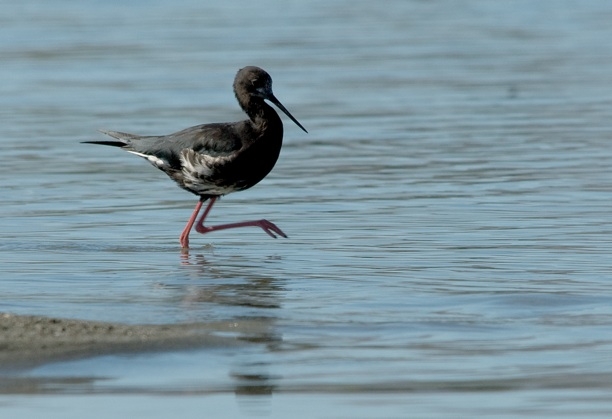Gene-puzzler
Genetic scientist Tammy Steeves is one of a few lab-rats in the country working closely with recovery groups to improve the genetic soup of our most imperilled species.
During her research career, she’s studied everything from the miniscule to the massive: marine snails to grey whales. Birds are now her focus.

- A kaki- poaka hybrid. Scientists have questioned whether cross-breeding of poaka-kaki populations could lead to the extinction of kaki through hybridisation. Photo: Dave Murray.
And since 2004, this Canadian-born scientist has worked in our birdland on the recovery of our most threatened tweeters – namely our critically endangered kaki, or black stilt.
In the 1980s, this Mackenzie country wader was down to only 23 birds putting it at great risk of a genetic bottleneck but since then it has bounced back with 98 adults to its name.
And recent studies have shown that despite its small population – it has a surprisingly diverse genetic pool.
However, this tidy genetic picture is sullied by the fact that kaki will breed with their closely related cousin the poaka, or pied stilt if they’re short of kaki mates. And these hybrids are fertile.
The hybrids aren’t the problem – it’s only when they breed back with kaki that the genetic pool can be muddied.
In other words, these cross-breeds might have the potential to flood the kaki gene pool such that we would lose them as a distinct genetic species. But have we?
To help keep the kaki genetic line alive, DOC has been breaking-up these kaki-hybrid mixed couples care of a few humanely aimed bullets for the past 10 years.
If there’s a kaki partner waiting in the wings, they remove the hybrid partner from the scene and then ensure any unpaired kaki singletons are matched accordingly.
It seems a drastic measure but then moving kaki away from poaka (and all of their predators) is not an option: there are no braided rivers on offshore islands.
We have to just lump the fact that kaki sometimes form pair bonds with hybrids or non-kaki – and that every so often, we’ll have to forcibly break them up. The good news is that as kaki numbers increase there are fewer and fewer of these mixed couples to worry about.
And although DOC has done its best to keep these lines clean, there had been numerous accounts of cross-breeding couples in the last 50 years. Poaka self-introduced to New Zealand over 150 years ago but hybrids really only started appearing when kaki numbers started plummeting in the mid-1900s.
The critical question remained – is the kaki gene pool littered with poaka DNA?
To find out whether this is the case, Steeves did a DNA analysis that included all the birds with kaki (black) plumage. Only one bird had poaka DNA (and he has since died of natural causes).
The result was welcomed by environmentalists as it showed that these birds were genetically distinct and worthy of protection – but it also raised a number of eyebrows – why?
The reason may lie in a kaki female drought that lasted for years. It’s thought that most of the mixed pairings came as a result of this over-abundance of kaki males.
Kaki males searching for potential partners may have settled for female hybrids – and thus had several broods of unsuccessful clutches. So very few genes got shared and the kaki’s genetic lines remained un-muddied.
You see, fertility in hybrids depends largely on gender and animal class. Typically, the sex with two different chromosomes suffers from reduced fertility when it’s a hybrid. In mammals, it’s the males (XY), but in birds it’s the females (ZW).
Fortunately, this female drought is over, meaning these cross-breeds are less common and the extinction by hybridisation is less critical.
Now that Steeves has got to the bottom of this conundrum – she’s moving on to genetic match-making.
However, instead of heading out into the field she’ll be trotting around museums analysing the DNA skin and bones samples from kaki ancestors to search for heritage genes that should be preseved in our current genetic stock.
Then she’ll head back to the lab and, working with DOC, will perform her match making genius to ensure the kaki’s genetic brew can see them through till the next century, and the next, and the next.
